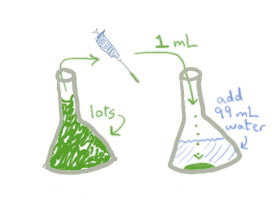Working out the dilution
When you're thinking about dilution, it helps to simplify your actions into dilution factors. When we said the diluted coffee was
"1/10th as strong as the original"
we were explaining how much the coffee was diluted. We could also have said
“the coffee was diluted 1/10”, or
“the coffee was diluted 10-1”, or, less frequently,
“the coffee was diluted 0.1”
Here are some more examples for you to try:
- 1 mL coffee + 4 mL water =
- 1 mL coffee + 9mL water =
- 1 mL + 99mL water =
As you've probably guessed, this works exactly the same whether you're talking about caffeine or bacterial cells. Here's what a dilution of 1/100, or 10-2, looks like on the lab bench:

Notice that it really doesn't matter how much of the original stock you started with, as long as you had enough to put 1 mL into the new container. What matters is how much you transfer and how much water you add. The dilution is then defined as:
Volume transferred / total volume
where the total volume is the volume transferred + volume of water added. Therefore,
1 / (1+99) = 1/100 = 10-2 = 0.01.
As shown above, the dilution can be expressed as a fraction (1/100), in scientific notation (10-2) or, less commonly, as a decimal (0.01). In this example, water is the diluent (a general term for the liquid used to dilute the sample).
In the applet below, give the dilution factor as a decimal:

What is the dilution factor?
1 mL stock + mL water
 Can you do it in your sleep? OK, then go on to the next page...
Can you do it in your sleep? OK, then go on to the next page...
photo credits: sleeping student |
Copyright University of Maryland, 2007
You may link to this site for educational purposes.
Please do not copy without permission
requests/questions/feedback email: mathbench@umd.edu